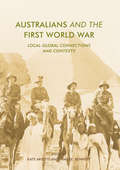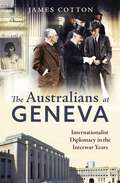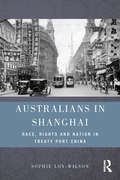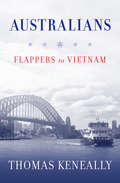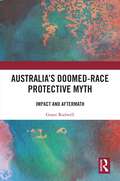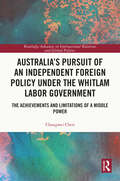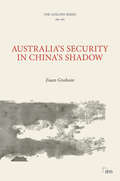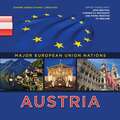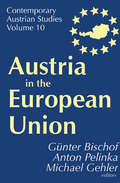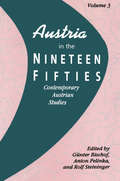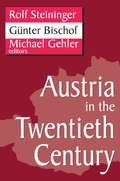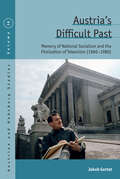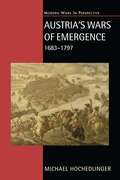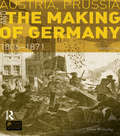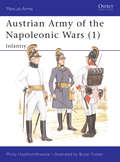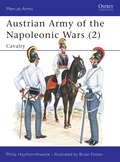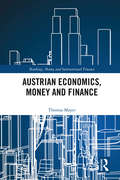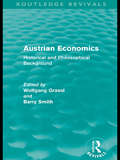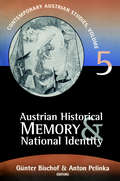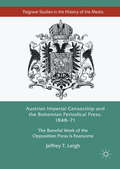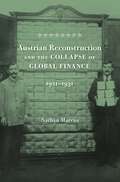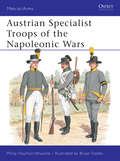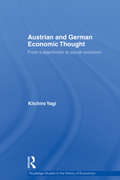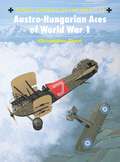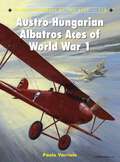- Table View
- List View
Australians and the First World War: Local-Global Connections and Contexts
by Kate Ariotti James E. BennettThis book contributes to the global turn in First World War studies by exploring Australians' engagements with the conflict across varied boundaries and by situating Australian voices and perspectives within broader, more complex contexts. This diverse and multifaceted collection includes chapters on the composition and contribution of the Australian Imperial Force, the experiences of prisoners of war, nurses and Red Cross workers, the resonances of overseas events for Australians at home, and the cultural legacies of the war through remembrance and representation. The local-global framework provides a fresh lens through which to view Australian connections with the Great War, demonstrating that there is still much to be said about this cataclysmic event in modern history.
Australians at Geneva: Internationalist Diplomacy in the Interwar Years
by James CottonAfter the dubious justice of the Treaty of Versailles and the turmoil of the interwar years, the League of Nations is mainly remembered as a body that failed to create mechanisms that might have forestalled the horrors of Nazism, fascism and the Second World War. It has understandably been overshadowed by the United Nations, that larger, more globally representative body which grew from the League, and which was founded on more unequivocally noble principles in the aftermath of a clear-cut victory of good over evil. But as the limitations of the United Nations become ever more apparent, we can look with more sympathy at the League and consider what we might learn from the endeavours of those driving this first attempt at global governmental coordination. As James Cotton relates in this illuminating account, a surprising number of Australians lent their talents and enthusiasm to this internationalist project, and Australian interests were prominently represented. Former Prime Minister Stanley Bruce was there, along with numerous other Australian men and women who made important contributions to international deliberations on questions of global organisation and interaction. This deeply researched and carefully realised story will recast understandings of both the League itself and the place within it of prominent interwar Australian internationalists.
Australians in Shanghai: Race, Rights and Nation in Treaty Port China
by Sophie Loy-WilsonIn the first half of the twentieth century, a diverse community of Australians settled in Shanghai. There they forged a ‘China trade’, circulating goods, people and ideas across the South China Sea, from Shanghai and Hong Kong to Sydney and Melbourne. This trade has been largely forgotten in contemporary Australia, where future economic ties trump historical memory when it comes to popular perceptions of China. After the First World War, Australians turned to Chinese treaty ports, fleeing poverty and unemployment, while others sought to ‘save’ China through missionary work and socialist ideas. Chinese Australians, disillusioned by Australian racism under the White Australia Policy, arrived to participate in Chinese nation building and ended up forging business empires which survive to this day. This book follows the life trajectories of these Australians, providing a means by which we can address one of the pervading tensions of race, empire and nation in the twentieth century: the relationship between working-class aspirations for social mobility and the exclusionary and discriminatory practices of white settler societies.
Australians: Flappers to Vietnam
by Thomas KeneallyThe third volume of Thomas Keneally’s history of the Australian people, Australians: Flappers to Vietnam chronicles the lives and deeds of Australians, both known and unknown, during the 20th century. Entering an age of consumerism, media, and communism, Australia underwent radical change in the hands of two less remembered prime ministers: the stoic Stanley Melbourne Bruce of the Melbourne Establishment and the humbler Irishman Jim Scullin of the Labor Party. Keneally examines the Great Crash, the rise of fascism, the reasons why Australia entered the Second World War through the massive unemployment that arrived later in the century. With a compassionate lens and rich storytelling, Flappers to Vietnam presents history in a fresh and vivid way.
Australia’s Doomed-Race Protective Myth: Impact and Aftermath
by Grant RodwellPeriodically, in Australian society racial chasms emerge portraying the great divide between Indigenous and non‑Indigenous Australians, exposing the sustained influence of the doomed‑race protective myth and its residue. This book exposes that a long and powerful influence on Australian society, economy, culture, and history has been the doomed‑race protective myth. While most nations harbour protective myths of one form or another, often endorsed by Australian governments at all levels and steeped in a cruel racism and, inter alia, a quest for pastoral lands, Australia’s doomed‑race protective myth has asserted an undue influence on First Nations people. This book argues the doomed race protective myth warped the vision of power elites, politicians, and bureaucrats. For centuries, sustained by representations in official and public history, schools, churches, and a whole host of public institutions, the doomed‑race protective myth has been voiced by almost every facet of non‑Indigenous Australian society, with pastoral Australia particularly benefiting. This book opens fresh vistas to the continuing racism in Australian society through an examination of the long‑politicised doomed‑race protective myth which was foisted on First Nations people, and with vested interests in pastoral Australia. Key events in Australia’s race‑relations history such as the 2023 First Nations Voice to Parliament Referendum have new light shed on them. Transnational themes relevant to Indigenous history have been examined. People with an interest in non‑Indigenous‑Indigenous affairs, academics, politicians and bureaucrats, and students will enjoy this book.
Australia’s Pursuit of an Independent Foreign Policy under the Whitlam Labor Government: The Achievements and Limitations of a Middle Power (Routledge Advances in International Relations and Global Politics)
by Changwei ChenThe election of the Whitlam-led Labor government in December 1972 ushered in fresh ideas and audacious initiatives in Australia’s foreign policy. Whitlam’s approach was shaped by a vision of taking Australia forward to its "rightful" and "independent" place in the future of the Asia Pacific region. Examining a series of episodes in Australia’s foreign relations under Whitlam, Chen pays attention to a broad range of hitherto insufficiently researched domestic and international issues in Australian’s foreign relations of the early 1970s. They range from immigration policy and the abolition of appeals from Australian Courts to the Privy Council to such major international issues as the Anglo-American base in Diego Garcia, French nuclear testing in the Pacific and the Five Power Agreement with respect to Malaysia and Singapore. Chen demonstrates how the pursuit of foreign policy independence repeatedly placed the Whitlam Government in a position wedged in between Australia’s traditional allies and the Third World; and how it navigated Australia’s national interests on a series of dilemma situations involving conflicting strategic interests between Australia and its traditional allies, and those between major powers and the non-aligned countries. The analysis presented in this book contributes to not only historical literature on the subject but also to the understanding of how a middle power, like Australia, can navigate intensifying great power rivalry. Essential reading for scholars of Australian foreign policy, as well as being an invaluable case study of Middle Power diplomacy in the Asia Pacific region.
Australia’s Security in China’s Shadow (Adelphi series)
by Euan GrahamA major shift in the paradigm undergirding relations between Australia and China has become clear in the early 2020s, with geopolitical concerns trumping economic considerations. Canberra has implemented a range of new policies in response to the risks it perceives in Australia’s economic relations with China, the Chinese Communist Party’s efforts to exert political influence in Australia, the expanding capabilities and presence of the People’s Liberation Army, and Beijing’s economic and diplomatic gains in Southeast Asia and the Southwest Pacific. China’s policies towards Australia have become more coercive in economic as well as diplomatic terms. However, Australia has withstood Beijing’s punitive trade measures without suffering significant economic damage. China’s more assertive regional posture has prompted far-reaching changes to Australia’s defence and alliance policy settings, including new capability acquisitions and strategic initiatives such as AUKUS. In this Adelphi book, Euan Graham argues that Australia has provided an imperfect but nevertheless useful exemplar of how governments may respond effectively to multifarious security challenges from China. In particular, the Australian case shows how measures to address domestic vulnerabilities may serve as the foundation for a successful China policy at the international level.
Austria (Major European Union Nations)
by Jeanine SannaAustria is a German-speaking country with a long history and rich cultural traditions, from kings and queens to musical composers. It has been a member of the EU since 1995. In today's world, Austria welcomes immigrants and struggles to deal with the financial troubles sweeping through Europe. Discover more about this exciting, modern nation!
Austria in the European Union (Contemporary Austrian Studies #Vol. 10)
by Günter Bischof, Anton Pelinka, and Michael GehlerAustria joined the European Union in 1995, with the overwhelming support of its citizenry. In June 1994, a record 66.6 percent of the Austrian population voted in favor of joining the Union, and Austria acceded on January 1, 1995. Only three years later, in the second half of 1998, Austria assumed its first presidency of the European Union. Its competent conduct of the Union's business enhanced its reputation. The sense that Austria was a role model collapsed overnight, after a new conservative People's Party (iVP/FPi) coalition government was formed in Austria in early February 2000. Austria became Europe's nightmare.This volume has two purposes. The first is to assess Austria's first five years in the European Union. The second is Austria's ongoing struggle with its past. Heinrich Neisser evaluates and assesses Austria's commitment to the European Union. Thomas Angerer offers a long-term perspective of regionalization and globalization trends in Austrian foreign affairs. Waldemar Hummer analyzes contradictions between Austrian neutrality and Europe's emerging common security policy. Johannes Pollak and Sonja Puntscher Rieckmann look at current debates over weighing future voting rights in the European Commission. Michael Huelshoff evaluates Austria's EU presidency in 1998 and compares it to the subsequent 1999 German presidency. Gerda Falkner examines the withering away of the previously much admired Austrian welfare state. Walter Manoschek scrutinizes the Nazi roots of Jorg Haider's Freedom Party. Michael Gehler critiques the EU sanctions and bemoans the absence of mediation through transnational Christian conservative parties.In reviewing how Austria deals with World War II, Richard Mitten investigates discourses on victimhood in postwar Austria and the place of Jews in this process. A "Roundtable" presents overwhelming evidence of Austrians' deep involvement in Nazi war crimes, and includes articles by Sabine Loitfellner and Winfried Garscha. This addition to the Contemporary Austrian Studies series will be welcomed by political scientists, historians and legal scholars, particularly those with a strong interest in European affairs.
Austria in the Nineteen Fifties
by Anton Pelinka Günter BischofIn American history the 1950s are remembered as an affluent and harmonious decade. Not so in Austria. That nation emerged out of World War II with tremendous war-related destruction and with a four-power occupation that would last for ten years until 1955. Massive American economic aid enabled the Austrian economy to start recovering in the 1950s and reorient it from East to West. Unlike the United States, however, general affluence did not set in until the 1960s and 1970s even though Austria's dramatic baby boom enabled it to recover from the demographic catastrophe resulting from manpower losses of World War II., This volume deals with these larger trends. Stephen E. Ambrose discusses American-European relations and sets the larger international context for the Austrian scene. Oilver Rathkolb retraces the changing importance of the Austrian question for the Eisenhower administration. Michael Gehler presents an in-depth analysis of the intriguing question of whether Austria's unification at the price of permanent neutrality might have been a model for Germany. Franz Mathis and Kurt Tweraser look at economic reconstruction and the roles played by both the Austrian public industrial sector and the American Marshall Plan. Karin Schmidlechner looks at the youth culture of the era. Franz Adlgasser shows how Herbert Hoover's food aid was instrumental in the containment of communism in Hungary. Beth Noveck analyzes Austrian political culture of the First Republic from the perspective of Hugo Bettauer. Rolf Steininger presents an insightful historical overview of how the Austro-Italian South Tyrol conflict was resolved after seventy-five years of tension.
Austria in the Twentieth Century (Studies in Austrian and Central European History and Culture #Vol. 1)
by Gino GermaniThese fourteen essays by leading Austrian historians and political scientists serve as a basic introduction to a small but sometimes trend-setting European country. They provide a basic up-to-date outline of Austria's political history, shedding light on economic and social trends as well. No European country has experienced more dramatic turning points in its twentieth-century history than Austria. This volume divides the century into three periods. The five essays of Section I deal with the years 1900-1938. Under the relative tranquility of the late Habsburg monarchy seethed a witch's brew of social and political trends, signaling the advent of modernity and leading to the outbreak of World War I and eventually to the collapse of the Habsburg Empire. The First Austrian Republic was one of the succession states that tried to build a nation against the backdrop of political and economic crisis and simmering civil war between the various political camps. Democracy collapsed in 1933 and an authoritarian regime attempted to prevail against pressures from Nazi Germany and Nazis at home. The two essays in Section II cover World War II (1938-1945). In 1938, Hitler's "Third Reich" annexed Austria and the population was pulled into the cauldron of World War II, fighting and collaborating with the Nazis, and also resisting and fleeing them. The seven essays of Section III concentrate on the Second Republic (1945 to the present). After ten years of four-power Allied occupation, Austria regained her sovereignty with the Austrian State Treaty of 1955. The price paid was neutrality. Unlike the turmoil of the prewar years, Austria became a "normal" nation with a functioning democracy, one building toward economic prosperity. After the collapse of the "iron curtain" in 1989, Austria turned westward, joining the European Union in 1995. Most recently, with the advent of populist politics, Austria's political system has experienced a sea of change departing from its political economy of a huge state-owned sector and social partnership as well as Proporz. This informed and insightful volume will serve as a textbook in courses on Austrian, German and European history, as well as in comparative European politics.
Austria's Difficult Past: Memory of National Socialism and the Filmization of Television (1960-1980) (Austrian and Habsburg Studies)
by Jakub Gortat GortatThe role played by film in reshaping Austria’s post-war national identity is often studied within narrow historical and geographical margins. Film history traditionally focuses on either the work of a sole director, German cinematography, or the immediate aftermath of World War II, and neglects the link that exists between historical television films and Austria’s distinct culture of remembrance. In Austria’s Difficult Past, Jakub Gortat addresses this gap by providing a comprehensive analysis of television films produced by Austrian (ORF) and German television studios between 1961 and 1980. In doing so, he explores the way films mediated the burden of memory and the legacy of Austria’s complicity in the Nazi regime.
Austria's Wars of Emergence, 1683-1797 (Modern Wars In Perspective)
by Michael HochedlingerThe Habsburg Monarchy has received much historiographical attention since 1945. Yet the military aspects of Austria’s emergence as a European great power in the seventeenth and eighteenth centuries have remained obscure. This book shows that force of arms and the instruments of the early modern state were just as important as its marriage policy in creating and holding together the Habsburg Monarchy.Drawing on an impressive up-to-date bibliography as well as on original archival research, this survey is the first to put Vienna’s military back at the centre stage of early modern Austrian history.
Austria, Prussia and The Making of Germany: 1806-1871 (Seminar Studies)
by John BreuillyIt is often argued that the unification of Germany in 1871 was the inevitable result of the convergence of Prussian power and German nationalism. John Breuilly here shows that the true story was much more complex. For most of the nineteenth century Austria was the dominant power in the region. Prussian-led unification was highly unlikely up until the 1860s and even then was only possible because of the many other changes happening in Germany, Europe and the wider world.
Austrian Army of the Napoleonic Wars
by Bryan Fosten Philip HaythornthwaitePacked with specially commissioned artwork, maps and diagrams, the Men-at-Arms series is an unrivalled illustrated reference on the history, organisation, uniforms and equipment of the world's military forces, past and present.
Austrian Army of the Napoleonic Wars: Cavalry
by Bryan Fosten Philip HaythornthwaiteThe mounted troops of the Hapsburg Empire comprised one of the most powerful forces of the Napoleonic Wars (1799-1815). However, from the outset the cavalry's higher command was less capable than its infantry counterpart: appointments were influenced by nepotism and politics, which resulted in commands often being given to those who lacked experience. The cavalry underwent many re-organisations and expansions in the course of the wars that attempted to redress these matters, and to modernise the force as a whole. This title examines these processes and documents in detail the tactics, uniforms and equipment of the Austrian cavalry, covering Cuirassiers, Dragoons, Chevauxlegers, Hussars, Uhlan (lancer) and auxiliary units.
Austrian Economics, Money and Finance (Banking, Money and International Finance)
by Thomas MayerThe financial crisis has exposed severe shortcomings in mainstream monetary economics and modern finance. It is surprising that these shortcomings have not led to a wider debate about the need to overhaul these theories. Instead, mainstream economists have closed ranks to defend existing theories and public authorities have expanded their interference in markets. This book investigates the problems associated with mainstream monetary economics and finance, and proposes alternatives based on the Austrian school of economics. This school emanated from the work of the nineteenth-century Austrian economist Carl Menger and was developed further by Eugen von Böhm-Bawerk, Ludwig von Mises, and Friedrich August von Hayek. In monetary economics, the Austrian school regards the creation of money by banks through credit extension as a key source of economic instability. From this follows the need for a comprehensive reform of our present monetary system. In a new monetary order, money could be issued by both public and private institutions, and there would be no need for fractional reserve banking. Instead of creating money, banks would intermediate it. In finance, the Austrian school rejects the notion of rational expectations and measurable risk. Individuals use their subjective knowledge to gather and evaluate information, and they act in a world of radical uncertainty. Hence, markets are not "efficient" nor can portfolios be built on the basis of known probability distributions of asset prices as described in the modern finance literature. This book explores the need for a new theoretical foundation for asset pricing and investment management that will give practitioners more useful orientation.
Austrian Economics: Historical and Philosophical Background (Routledge Revivals)
by Wolfgang GrasslFirst published in 1986, this book presents a reissue of the first detailed confrontation between the Austrian school of economics and Austrian philosophy, especially the philosophy of the Brentano school. It contains a study of the roots of Austrian economics in the liberal political theory of the nineteenth-century Hapsburg empire, and a study of the relations between the general theory of value underlying Austrian economics and the new economic approach to human behaviour propounded by Gary Becker and others in Chicago. In addition, it considers the connections between Austrian methodology and contemporary debates in the philosophy of the social sciences.
Austrian Historical Memory and National Identity (Contemporary Austrian Studies #Vol. 14)
by Anton Pelinka Gunter BischofWhen the Hapsburg monarchy disintegrated after World War I, Austria was not considered to be a viable entity. In a vacuum of national identity the hapless country drifted toward a larger Germany. After World War II, Austrian elites constructed a new identity based on being a "victim" of Nazi Germany. Cold war Austria, however, envisioned herself as a neutral "island of the blessed" between and separate from both superpower blocs. Now, with her membership in the European Union secured, Austria is reconstructing her painful historical memory and national identity. In 1996 she celebrates her 1000-year anniversary.In this volume of Contemporary Austrian Studies, Franz Mathis and Brigitte Mazohl-Wallnig argue that regional identities in Austria have deeper historical roots than the many artificial and ineffective attempts to construct a national identity. Heidemarie Uhl, Anton Pelinka, and Brigitte Bailer discuss the post-World War II construction of the victim mythology. Robert Herzstein analyses the crucial impact of the 1986 Waldheim election imploding Austria's comforting historical memory as a "nation of victims." Wolfram Kaiser shows Austria's difficult adjustments to the European Union and the larger challenges of constructing a new "European identity." Chad Berry's analysis of American World War II memory establishes a useful counterpoint to construction of historical memory in a different national context.A special forum on Austrian intelligence studies presents a fascinating reconstruction by Timothy Naftali of the investigation by Anglo-American counterintelligence into the retreat of Hitler's troops into the Alps during World War II. Rudiger Overmans' "research note" presents statistics on lower death rates of Austrian soldiers in the German army. Review essays by Gunther Kronenbitter and Gunter Bischof, book reviews, and a 1995 survey of Austrian politics round out the volume. Austrian Historical Memory and National Identity will be of intense interest to foreign policy analysts, historians, and scholars concerned with the unique elements of identity and nationality in Central European politics.
Austrian Imperial Censorship and the Bohemian Periodical Press, 1848–71: The Baneful Work of the Opposition Press is Fearsome (Palgrave Studies in the History of the Media)
by Jeffrey T. LeighThis book analyzes the conduct of press policy in Bohemia from the Revolutions of 1848 through the period of the T#65533;bory, 1867-71. In the aftermath of the revolutions, the Habsburg state, far from constituting an historical relic, proved itself boldly innovative, inaugurating liberal reforms, most importantly the rule of law. While the reforms helped it to survive its immediate challenges, they nonetheless, quite paradoxically, created an environment in which the periodical press continued to advance perspectives emblematic of the revolution, even during the era of Neoabsolutism. This new legal environment fostered the rise of the bourgeois public sphere, as theorized by J#65533;rgen Habermas, and the very political movements that would contribute to its demise, as signaled in the T#65533;bory campaign of 1867-71. At the nexus of civil society and the state stood the provincial Habsburg officials responsible for public order and security. Their experience was one of endeavoring to balance the ideals of the rule of law imposed by the Imperial center and their own vital concerns regarding the survival of the Monarchy. This work, for the first time, concentrates on the role of these officials who determined what would--and would not--appear in print.
Austrian Reconstruction and the Collapse of Global Finance, 1921–1931
by Nathan MarcusAlthough some statesmen and historians have pinned Austria’s—and the world’s—interwar economic implosion on financial colonialism, in this corrective history Nathan Marcus deemphasizes the negative role of external players and points to the greater impact of domestic malfeasance and predatory speculation on Austrian political and financial decline.
Austrian Specialist Troops of the Napoleonic Wars
by Bryan Fosten Philip HaythornthwaiteThe specialist troops of the Austrian forces helped to secure Austria's reputation as the most formidable of Napoleon's continental enemies. Due largely to the efforts of Prince Liechtenstein, by the late 18th century the Austrian artillery had been the finest in Europe, and was held up as an example to the world. This text examines the famed Austrian artillery and other specialist troops of the Napoleonic Wars (1799-1815), including the Pioneers, Pontooneers, engineer services and medical service, detailing their organisation, equipment and uniforms in a volume complete with accompanying illustrations and colour plates.
Austrian and German Economic Thought: From Subjectivism to Social Evolution (Routledge Studies In The History Of Economics Ser. #123)
by Kiichiro YagiThis book intends to renovate the view of social sciences in the German-speaking world. It explores the intellectual tension in the social science in Austria and Germany in the late-nineteenth and early-twentieth centuries. It deals with how the emergence of the new school (Austrian School) changed the focus of social science in the German speaking world, and how it prepared the introduction of an evolutionary perspective in economics, politics, and sociology. Based on (mostly hitherto unknown) primary evidence, this development is lively described in a series of encounters and decisions by each social scientists.
Austro-Hungarian Aces of World War 1
by Mark Rolfe Chris ChantStarting the war with only 35 aircraft, Austro-Hungarian industry went on to produce only moderate numbers of poor quality aircraft. The fliers of the Austro-Hungarian Empire operating on the Serbian and Russian fronts were fortunate at first, finding themselves faced by small numbers of aircraft yet more obsolescent than their own. Serbia fell in 1915, but when Italy declared war the Austro-Hungarians were still faced with a two-front war - a static front against Italy, and a far more fluid one against Russia. Austro-Hungarian fighter pilots performed bravely and often very effectively under extremely difficult geographic, climatic and operational conditions.
Austro-Hungarian Albatros Aces of World War 1
by Harry Dempsey Paolo VarrialeAustro-Hungarian industry produced a series of poor fighter types such as the Phönix D I and Hansa-Brandenburg D I during the early stages of the war, and it was not until licence-built examples of the battle-proven Albatros and D II and D III began to reach Fliegerkompagnien, or Fliks, in May 1917 that the fortunes of pilots began to look up. Unlike the German-built Albatrosen, which initially suffered wing failures in flight, the Oeffag aircraft were far more robust than German D IIs and D IIIs. They also displayed superior speed, climb, manoeuvrability and infinitely safer flight characteristics. Such attributes were used to the full by all the leading Austro-Hungarian aces, including Brumowski, Arigi, Kiss and Linke-Crawford, who fought Italian pilots in Hanriots and SPADs, as well as British pilots in Camels and Bristol Fighters. The exploits of Austro-Hungarian aces were initially brought to the attention of English-speaking readers in the 1980s through the pioneering work of Martin O'Connor. An additional 30 years of additional research has allowed Paolo Varriale to integrate and update his work, rectifying some inaccuracies and adding new details and a large number of unpublished photographs. The careful crosschecking of Allied sources with Austrian and German records form the basis for a detailed reconstruction of the dogfights fought by the leading aces. This painstaking research allows many myths to be exposed and errors to be corrected. The book will cover the use of Albatros fighters on the Italian and Eastern Fronts, from the fighters' initial arrival in mid 1917 through to the last days of war. It will also chart the careers of the Austro-Hungarian aces that flew the D II and D III, their successes and their defeats, with additional information about their personal background and their post-war lives in the nations born from the collapse of the Hapsburg Empire. Some 49 pilots achieved acedom during World War 1, and the bulk of these pilots made their claims flying the 586 Oeffag-built Albatrosen.
